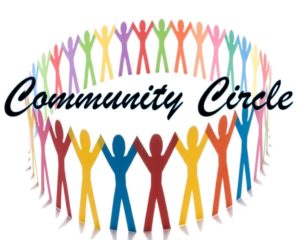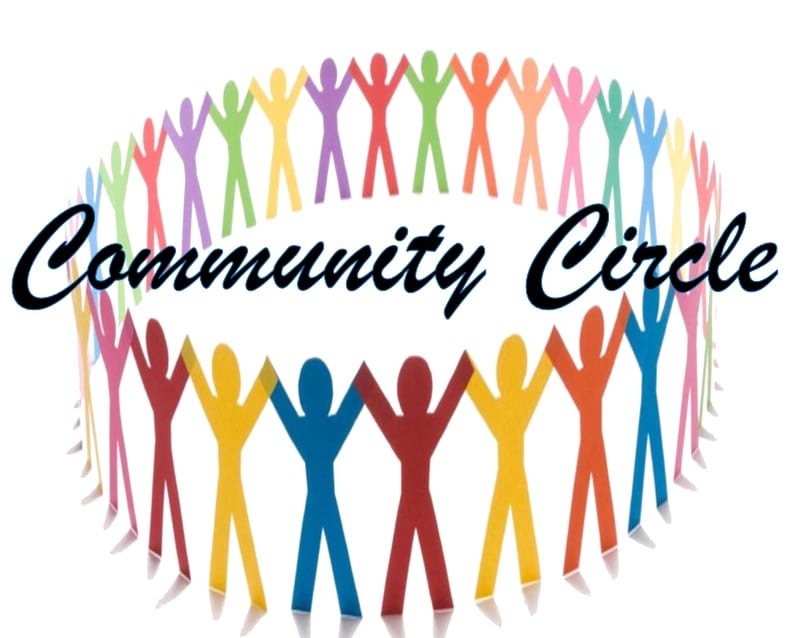Student Contributor: H. Stinger
 The community circle is a tool where teachers have students sit alongside them in a circle and talk about a prompt that the teacher gives. Students then pass around a certain object and share their thoughts and feelings about that prompt. This tool is helpful in a classroom because it gives the class the opportunity to express their thoughts, feelings, and ideas about the topic at hand.
The community circle is a tool where teachers have students sit alongside them in a circle and talk about a prompt that the teacher gives. Students then pass around a certain object and share their thoughts and feelings about that prompt. This tool is helpful in a classroom because it gives the class the opportunity to express their thoughts, feelings, and ideas about the topic at hand.
This tool is set up with every student and the teacher sitting in a circle on the same level (sitting on the floor, sitting in chairs, or standing up). The teacher prompts a question or a statement for the class to reflect on for about a minute before the activity starts (the prompt could be about something learned in class that day or a class problem that needs to be addressed). Whoever starts passes around an object and whoever has that object is the person that is able to share (objects could include teddy bear, ball, rain stick, ball of yarn etc.). Everyone always has the right to pass if they are not comfortable sharing. This activity may start off awkward at first, but the more teachers utilize this tool the more comfortable students will start to become with each other. When we used this tool in class, it was really cool to hear from my peers on their thoughts about the topic at hand that Gus had prompted. My favorite usage of this tool is when we use acknowledging words to recognize kind things about each other when most of the time people feel go unnoticed.
 This is an example of the supportive phase. It’s supportive because it occurs during learning and mainly, at the end of learning to sum up something. Community circle is a great example of community building because the class gets the ability to lift each other up and promote positivity. It does relate a little bit to preventative because by discussing certain topics about behavior, students may be prevented from doing a certain behavior again. Overall, this is mainly a collaborative/student-directed theory because the students get to choose how they respond but, the response is based off of a prompt that the teacher chose for the students to discuss. This really illustrates the ideas of students and the teacher working together to make the community circle operate. Once the teacher gives the prompt to the students, it’s up to the students how they want to respond or respond at all.
This is an example of the supportive phase. It’s supportive because it occurs during learning and mainly, at the end of learning to sum up something. Community circle is a great example of community building because the class gets the ability to lift each other up and promote positivity. It does relate a little bit to preventative because by discussing certain topics about behavior, students may be prevented from doing a certain behavior again. Overall, this is mainly a collaborative/student-directed theory because the students get to choose how they respond but, the response is based off of a prompt that the teacher chose for the students to discuss. This really illustrates the ideas of students and the teacher working together to make the community circle operate. Once the teacher gives the prompt to the students, it’s up to the students how they want to respond or respond at all.
More Information –
Tool Source: Gus Nollmeyer



4th grade
25 students
Suburban
My placement has time set aside once a week, Wednesday mornings, after students complete their entry task to have their “Class Meeting”. During the class meeting we all sit in a circle around the classroom (teachers included) and discuss a topic. Usually we start off going around the circle answering a question (examples: What was a high and low of the weekend, a would you rather question, or something we are looking forward to.) There is a squishy ball passed around as the talking token and each student has the opportunity to participate, or pass. After the topic of the meeting is discussed and as time allows, the ball is passed around to award students “Stars”, which are compliments to one another. This is a supportive tool because it allows students to speak freely and gives them a platform to express their ideas as a contributive student in the classroom.
24 Students
Third Grade
I introduced community circle to my third-grade students, and they loved it. My third graders constantly ask to do community circle, but we are still working on appropriate community circle behavior. Students are still working on only talking when they have the talking stick, but I have seen the classroom develop into a great community. Students are engaging more with classmates that they would not consider their best friend. I have also witnessed the reserved students breaking out of their shell to share. I think that the students partially understand the purpose of community circle, but they have not reached the point of fulfilling that role to the best of their ability. I have determined that the tool itself does not need any adjustments as a concept itself, however I need to work on the implementation to create the best community circle that I can. I think that the more practice I have, the better students will understand their roles and the purpose of community circle.